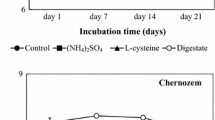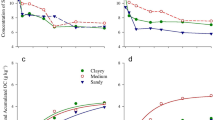Abstract
Degradation and fate of sulfamethazine (SMZ) were determined under aerobic and anaerobic conditions in soil with and without swine manure amendment. For both aerobic and anaerobic conditions, SMZ disappeared rapidly during the first 7 days followed by slow disappearance which may indicate that SMZ had become more persistent and less available. For soils receiving 100 mg/kg of SMZ, the percent of SMZ remaining in the soil after 63 days were between 25 and 60 %. Depending on the initial SMZ concentration, estimated half-lives for aerobic and anaerobic incubations ranged from 1.2 to 6.6 and 2.3 days to more than 63 days, respectively. Addition of manure (0.054 g/g soil) did not significantly affect the half-lives of SMZ. Inhibitory effects of SMZ on anaerobic microbial respiration were observed in unamended soil at concentrations of 50 mg/kg or higher, but only transient inhibitory effects were found in aerobic soil. Five to 22 % of the 14C[phenyl]-SMZ added were extracted at the end of the incubations while 70 to 91 % of the 14C were converted to bound (non-extractable) forms in both manure amended and unamended soil. Only 0.1 to 1.5 % of 14C-SMZ was mineralized to 14CO2. Disappearance of SMZ in sterilized soil was not completely halted indicating possible contribution of abiotic processes to the disappearance of SMZ in soil.




Similar content being viewed by others
References
Accinelli, C., Koskinen, W. C., Becker, J. M., & Sadowsky, M. J. (2007). Environmental fate of two sulphonamide antimicrobial agents in soil. Journal of Agricultural and Food Chemistry, 55, 2677–2682.
Amarakoon, I. D., Zvomuya, F., Cessna, A. J., Degenhardt, D., Larney, F. J., & McAllister, T. A. (2014). Runoff losses of excreted chlortetracycline, sulfamethazine, and tylosin from surface-applied and soil incorporated beef cattle feedlot manure. Journal of Environmental Quality, 43, 549–577.
Anhalt, J. C., Moorman, T. B., & Koskinen, W. C. (2008). Degradation and sorption of imidacloprid in dissimilar surface and subsurface soils. Journal of Environmental Science and Health, Part B, 43, 207–213.
Aust, M.-O., Godlinski, F., Travis, G. R., Hao, X., McAllister, T. A., Leinweber, P., & Thiele-Bruhn, S. (2008). Distribution of sulfamethazine, chlorotetracycline and tylosin in manure and soil of Canadian feedlots after subtherapeutic use in cattle. Environmental Pollution, 156, 1243–1251.
Awad, Y. M., Kim, S., Abd El-Azeem, S. A. M., Kim, K. H., Kim, K. R., Kim, K. J., Jeon, C., Lee, S. S., & Ok, Y. S. (2014). Veterinary antibiotics contamination in water, sediment, and soil near a swine manure composting facility. Environmental Earth Sciences, 71, 1433–1440.
Bialk, H. M., Simpson, A. J., & Pedersen, J. A. (2005). Cross-coupling of sulphonamide antimicrobial agents with model humic constituents. Environmental Science and Technology, 39, 4463–4473.
Blackwell, P. A., Boxall, A. B. A., Kay, P., & Nobel, H. (2005). An evaluation of a lower tier exposure assessment model for veterinary medicines. Journal of Agricultural and Food Chemistry, 53, 2192–2201.
Blackwell, P. A., Kay, P., & Boxall, A. B. A. (2007). The dissipation and transport of veterinary antibiotics in a sandy loam soil. Chemosphere, 67, 292–299.
Boxall, A. B. A., Fogg, L. A., Blackwell, P. A., Kay, P., Pemberton, E. J., & Croxford, A. (2004). Veterinary medicines in the environment. Reviews of Environment Contamination and Toxicology, 180, 1–91.
Campagnolo, E. R., Johnson, K. R., Karpati, A., Rubin, C. S., Kolpin, D. W., Meyer, M. T., Esteban, J. E., Currier, R. W., Smith, K., Thu, K. M., & McGeehin, M. (2002). Antimicrobial residues in animal waste and water resources proximal to large-scale swine and poultry feeding operations. Science of the Total Environment, 299, 89–95.
Garcia-Galán, M. J., Diaz-Cruz, M. S., & Barceló, D. (2008). Identification and determination of metabolites and degradation products of sulfonamide antibiotics. Trends in Analytical Chemistry, 27, 1008–1022.
Haller, M. Y., Müller, S. R., McArdell, C. S., Alder, A. C., & Suter, M. J. F. (2002). Quantification of veterinary antibiotics (sulphonamides and trimethoprim) in animal manure by liquid chromatography-mass spectrometry. Journal of Chromatography, A, 952, 111–120.
Hamscher, G., Pawelzick, H. T., Höper, H., & Nau, H. (2005). Different behavior of tetracyclines and sulfonamides in sandy soils after repeated fertilization with liquid manure. Environmental Toxicology and Chemistry, 24, 861–868.
Heise, J., Höltge, S., Schrader, S., & Kreuzig, R. (2006). Chemical and biological characterization of non-extractable sulfonamide residues in soil. Chemosphere, 65, 2352–2357.
Henderson, K.L.D., Moorman, T.B., Coats, J.L. (2009). Fate and bioavailability of sulfamethazine in freshwater ecosystems. In K. Henderson, et al.(Eds.), Veterinary Pharmaceuticals in the Environment. ACS Symp. Series, Am, Chem. Soc., Wash. D.C.
Heuer, H., Solehati, K., Zimmerling, U., Kleineidam, K., Schloter, M., Műller, T., Focks, A., Thiele-Bruhn, S., & Smalla, K. (2011). Accumulation of sulfonamide resistance genes in arable soils due to repeated application of manure containing sulfadiazine. Applied and Environmental Microbiology, 77, 2527–2530.
Kahle, M., & Stamm, C. (2007). Time and pH-dependent sorption of the veterinary antimicrobial sulfathiazole to clay minerals and ferrihydrite. Chemosphere, 68, 1224–1231.
Kay, P., Blackwell, P. A., & Boxall, A. B. A. (2004). Fate of veterinary antibiotics in a macroporous tile drained clay soil. Environmental Toxicology and Chemistry, 23, 1136–1144.
Kreuzig, R., & Höltage, S. (2005). Investigations on the fate of sulfadiazine in manured soil: laboratory experiments and test plot studies. Environmental Toxicology and Chemistry, 24, 771–776.
Kreuzig, R., & Höltage, S. (2006). Chemical and biological characterization of non-extractable sulfonamide residues in soil. Chemosphere, 65, 2352–2357.
Krogh, K. A., Jensen, G. G., Schneider, M. K., Fenner, K., & Halling-Sørensen, B. (2009). Analysis of the dissipation kinetics of ivermectin at different temperatures and in four different soils. Chemosphere, 75, 1097–1104.
Lertpaitoonpan, W., Ong, S. K., & Moorman, T. (2009). Effect of organic carbon and pH on soil sorption of sulfamethazine. Chemosphere, 76, 558–564.
Liang, B. C., Gregorich, E. G., Schnitzer, M., & Schulten, H. R. (1996). Characterization of water extracts of two manures and their adsorption on soils. Soil Science Society of America Journal, 60, 1758–1763.
Paulson, G. D., Giddings, J. M., Lamoureux, C. H., Mansager, E. R., & Struble, C. B. (1981). The isolation and identification of 14C-sulfamethazine [4-amino-N-(4,6-dimethyl-2-pyrimidinyl)[14C]benzenesulfonamide] metabolites in the tissues and the excreta of swine. Drug Metabolism and Disposition, 9, 142–146.
Sapkota, A. R., Curriero, R. C., Gibson, K. E., & Schwab, K. J. (2007). Antibiotic-resistant Enterococci and fecal indicators in surface water and groundwater impacted by a concentrated swine feeding operation. Environmental Health Perspectives, 115, 1040–1045.
Sarmah, A. K., Meyer, M. T., & Boxall, A. B. A. (2006). A global perspective on the use, sales, exposure pathways, occurrence, fate and effects of veterinary antibiotics (VAs) in the environment. Chemosphere, 65, 725–759.
Schauss, K., Focks, A., Heuer, H., Kotzerke, A., Schmitt, H., Thiele-Bruhn, S., Smalla, K., Wilke, B.-M., Matthies, M., Amelung, W., Klasmeier, J., & Schloter, M. (2009). Analysis, fate and effects of the antibiotic sulfadiazine in soil ecosystems. Trends in Analytical Chemistry, 28, 612–618.
Schmidt, B., Ebert, J., Lamsöhft, M., Thiede, B., Schumacher-Buffel, R., Ji, R., Corvini, P. F. X., & Schäffer, A. (2008). Fate in soil of 14C-sulfadiazine residues contained in the manure of young pigs treated with a veterinary antibiotic. Journal of Environmental Science and Health, Part B, 43, 8–20.
Sengeløv, G. Y., Agerso, Y., Halling-Sørensen, B., Baloda, S. B., Andersen, J. S., & Jensen, L. B. (2003). Bacterial antibiotic resistance levels in Danish farmland as a result of treatment with pig manure slurry. Environment International, 28, 589–595.
Skold, O. (2000). Sulfonamide resistance: mechanisms and trends. Drug Resistance Updates, 3(3), 155–160.
Stoob, K., Singer, H. P., Stettler, S., Hartman, N., Mueller, S. R., & Stamm, C. P. (2006). Exhaustive extraction of sulfonamide antibiotics from aged agricultural soils using pressurized liquid extraction. Journal of. Chromatography A, 1128, 1–9.
Tappe, W., Herbst, M., Hofmann, D., Koeppchen, S., Kummer, S., Thiele, B., & Groeneweg, J. (2011). Degradation of sulfadiazine by Microbacterium lacus Strain SDZm4, isolated from lysimeters previously manured with slurry from sulfadiazine-medicated pigs. Applied and Environmental Microbiology, 79(8), 2572–2577.
ter Laak, T. L., Gebbink, W. A., & Tolls, J. (2006). The effect of pH and ionic strength on the sorption of sulfachloropyridazine, tylosin, and oxytetracycline to soil. Environmental Toxicology and Chemistry, 25, 904–911.
Thiele-Bruhn, S., & Aust, M. O. (2004). Effects of pig slurry on the sorption of sulphonamide antibiotics in soil. Archives of Environment Contamination and Toxicology, 47, 31–39.
Thiele-Bruhn, S., & Beck, I. C. (2005). Effects of sulfonamide and tetracycline antibiotics on soil microbial activity and microbial biomass. Chemosphere, 59, 457–465.
Tolls, J. (2001). Sorption of veterinary pharmaceuticals in soils: a review. Environmental Science and Technology, 35, 3397–3406.
Topp, E., Chapman, R., Devers-Lamrani, M., Hartmann, A., Marti, R., Martin-Laurent, F., Sabourin, L., Scott, A., & Sumarah, M. (2012). Accelerated biodegradation of veterinary antibiotics in agricultural soil following long-term exposure, and isolation of a sulfamethazine-degrading Microbacterium sp. Journal of Environmental Quality, 42, 173–178.
Wang, Q., & Yates, S. R. (2008). Laboratory study of oxytetracycline degradation kinetics in animal manure and soil. Journal of Agricultural and Food Chemistry, 56, 1683–1688.
Wang, M.-J., McGrath, S. P., & Jones, K. C. (1995). Chlorobenzenes in field soil with a history of multiple sewage sludges applications. Environmental Science and Technology, 29, 356–362.
Wang, Q.-Q., Bradford, S. A., Zheng, W., & Yates, S. R. (2006a). Sulfadimethoxine degradation kinetics in manure as affected by initial concentration, moisture, and temperature. Journal of Environmental Quality, 35, 2162–2169.
Wang, Q., Guo, M., & Yates, S. R. (2006b). Degradation kinetics of manure-derived sulfadimethoxine in amended soil. Journal of Agricultural and Food Chemistry, 54, 157–163.
Wehrhan, A., Streck, T., Groenweg, J., Vereecken, H., & Kasteel, R. (2010). Long-term sorption and desorption of sulfadiazine in soil: experiments and modeling. Journal of Environmental Quality, 39, 654–666.
Yang, J. F., Ying, G. G., Yang, L. H., Zhao, J. L., Feng, L., Tao, R., Yu, Z. Q., & Peng, P. (2009). Degradation behavior of sulfadiazine in soils under different conditions. Journal of Environmental Science and Health, Part B, 44, 241–248.
Author information
Authors and Affiliations
Corresponding author
Rights and permissions
About this article
Cite this article
Lertpaitoonpan, W., Moorman, T.B. & Ong, S.K. Effect of Swine Manure on Sulfamethazine Degradation in Aerobic and Anaerobic Soils. Water Air Soil Pollut 226, 81 (2015). https://doi.org/10.1007/s11270-014-2286-1
Received:
Accepted:
Published:
DOI: https://doi.org/10.1007/s11270-014-2286-1




